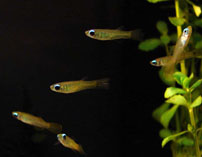| Family: |
Procatopodidae (African lampeyes), subfamily: Procatopodinae |
| Max. size: |
4.5 cm TL (male/unsexed); 4 cm TL (female) |
| Environment: |
benthopelagic; freshwater; pH range: 6.5 - 7.19999980926514, non-migratory |
| Distribution: |
Africa: rivers in Senegal, Gambia, Guinea, Sierra Leone, Liberia, Mali, Burkina Faso, Côte d'Ivoire, Ghana, Niger, Nigeria, Cameroon and Chad (Ref. 57259), Benin and Togo (Ref. 27139); also river drainages in Central African Republic (Ref. 3788) and White Nile in Sudan (Ref. 3788, 7372). |
| Diagnosis: |
Dorsal spines (total): 0-0; Dorsal soft rays (total): 6-8; Anal spines: 0-0; Anal soft rays: 9-12. Diagnosis: small but relatively deep-bodied ‘Lampeye’ species with fairly long unpaired fins; adult males with long ventral fins that may reach to the end of the anal fin; dorsal fin with 6-8 rays, anal fin with 9-12 rays, displacement between dorsal and anal fins 1/4-7; scales on mid-lateral series 24-27 (Ref. 57259).
Description: With 24-27 scales in longitudinal series (Ref. 28714, 57259).
Colouration: Male colouration: the body is translucent pale olive, with an evenly distributed light blue iridescence on the sides; most populations have narrow dark brown edgings to the scales on the back and the sides, but in some other populations this feature is barely visible; also variable at the population level is the colour of the unpaired fins, which may vary between pale shades of yellow, red, orange and violet; some populations also show a light blue iridescence at the base of these fins; dark grey spots, interspersed with lighter spots, are present on the posterior parts of the dorsal and anal fins; the caudal fin has some grey, crescent-shaped crossbars and, in most populations, a small, relatively light triangular lobe in the lower part (Ref. 57259). Female colouration: translucent olive-grey, with a light silver iridescence on the sides and narrow dark edgings to the scales on the back and the sides; all fins are colourless (Ref. 57259). Both sexes have a striking light blue reflective spot in the upper part of the iris (Ref. 57259). |
| Biology: |
A savannah dwelling species found in, or close to, vegetated parts of small rivers, brooks, and swamps (Ref. 7372, 57259). Not a seasonal killifish. Is easy to maintain in the aquarium (Ref. 27139). |
| IUCN Red List Status: |
Least Concern (LC); Date assessed: 07 June 2019 Ref. (130435)
|
| Threat to humans: |
harmless |
Source and more info: www.fishbase.org. For personal, classroom, and other internal use only. Not for publication.

